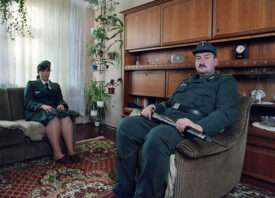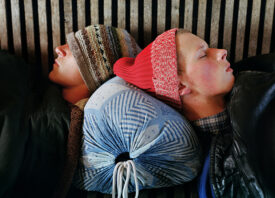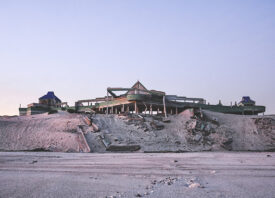Search this site
Haunting Images from ‘Poland’s Rust Belt’

“A shortcut across a frozen lake.” © Tomasz Liboska

“Mieczyslaw no longer works at the mine, but at least no one cares about his long hair anymore.” © Tomasz Liboska

“A mother worries about her son’s fading football club emblem. When the colors are gone, she won’t be able to revive them. Her son died of a heart attack.” © Tomasz Liboska
“In the communist era, Upper Silesia was the promised land,” Polish photographer Tomasz Liboska told us of the place he’s called home for ten years. People from all over the country came to Upper Silesia following the Second World War in search of hard work and prosperity for their families. Steel plants and coal mines flourished.
The industry floundered in the 1980s, when Poland switched over to a capitalist economy. Factories and plants were shuttered; jobs were lost, and people moved on. “Today, after twenty-something years, there is little evidence left of the golden days,” Liboska explained. He describes Upper Silesia as “Poland’s Rust Belt.”
In some ways, the photographer’s own life contradicts the familiar narrative of the region. While others have left, he has built his life and his family here. Turn Round is his ongoing documentation of his surroundings, made during many bicycle trips through the neighborhood. He makes pictures during the pauses in daily life, usually on his commute to work.
These days, he finds young people moving to Upper Silesia. New business are opening, and night clubs are a part of the everyday scenery. “However,” the photographer said, “there are still enclaves, places where the void of the terminated coal mine or steelwork still remains unfilled.” While part of the population thrives, others have been left behind.
The subjects of Liboska’s pictures include friends and acquaintances, but each and every portrait was made with permission. He also listened to these men and women and learn about their lives. He’s had dinner and coffee with many of them. “There are often very touching stories hidden behind a picture,” he admitted, “but there is still room for some humor.”
And in spite of drastic transformations, the mythos of Upper Silesia remains. If you mention the region to people in other parts of Poland, Liboska said, they will imagine the plumes of chimney smoke that once colored the horizon. In the photographer’s words, residents of Upper Silesia are considered by the larger population to be “tough and honest.”
Upper Silesia might have turned out not to be the promised land, but it’s now Liboska’s land, and he’s content with that. “It is my place,” he told me. I asked him what he sees for the future of the region. “Exactly what I see for my own future,” he replied, “Only good things.”
Follow Tomasz Liboska on Instagram for more from Upper Silesia.

“This man is about to sell his house.” © Tomasz Liboska

“The A4 motorway is the fastest route to Germany, where thousands of people from Upper Silesia settled down after emigrating.” © Tomasz Liboska

“Typical urban architecture, erected in the times of socialist prosperity.” © Tomasz Liboska

“Jurek loves painting. He built his ranch entirely out of trash and random findings.” © Tomasz Liboska

“This East German Trabant hasn’t been used for years.” © Tomasz Liboska

“A steel plant in one of the region’s cities, called Bytom, used to be the main employer in the city. It shut down in 1994.” © Tomasz Liboska

“A man on his way back from the scrapyard, where he managed to sell a few aluminum cans.” © Tomasz Liboska



